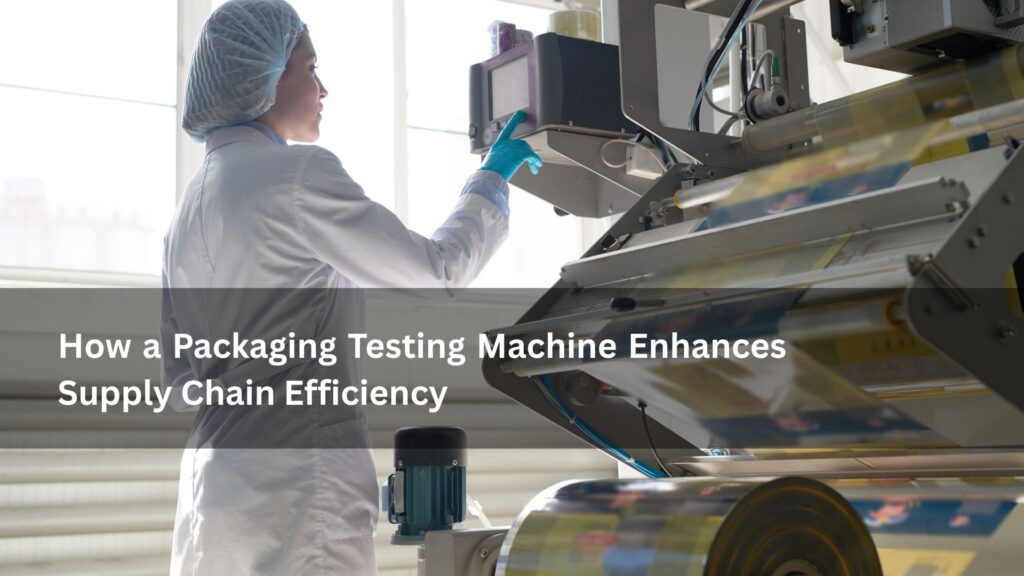Packaging Testing Machine: An Essential Tool in Logistics
At its core, a Packaging Testing Machine is a device used to evaluate the mechanical and environmental durability of packaging materials. These machines subject packaging samples to a variety of stress conditions — such as compression, vibration, drop impact, temperature, and humidity — to simulate real-world transport and storage challenges.
In logistics, packages are not treated gently. They are stacked, dropped, exposed to moisture, subjected to vibrations during road or sea travel, and compressed under heavy loads. Any of these forces can cause the packaging to fail if it is not adequately designed or tested. A Packaging Testing Machine helps logistics teams and manufacturers anticipate and mitigate these risks by validating whether the packaging can survive such conditions.
For example, an e-commerce warehouse shipping fragile electronics to customers in distant countries must be confident that the packaging can protect the product even during harsh transit. Testing that packaging ahead of time with a Packaging Testing Machine ensures that when the product leaves the warehouse, it stands a much higher chance of arriving safely — reducing returns, replacements, and shipping inefficiencies.
Why a Packaging Testing Machine Is Crucial in Modern Supply Chains
The evolution of global logistics has made the Packaging Testing Machine more relevant than ever. As companies ship products worldwide, they face a variety of handling and climate conditions that can easily damage untested packaging. A Packaging Testing Machine provides consistency and reliability by reproducing those conditions in a controlled environment.
Additionally, many retailers and logistics providers have strict packaging standards. A failure to comply can result in rejected shipments or additional charges. With a Packaging Testing Machine, businesses can ensure their packaging meets the criteria set by these third-party handlers.
Reducing Damaged Goods with a Packaging Testing Machine
Damage during transit is a major cause of inefficiency and cost in the supply chain. It leads to product waste, customer complaints, replacement shipments, and reverse logistics processes that drain resources. For high-volume operations, even a 1% rate of damaged goods can translate to significant financial losses.
A Packaging Testing Machine dramatically reduces the likelihood of such issues by:
Identifying packaging weaknesses: Testing reveals flaws in box construction, sealing strength, or internal cushioning.
Simulating real transit conditions: Machines can replicate truck vibration, sudden drops, and warehouse stacking to stress-test the packaging.
Quantifying tolerance levels: Understanding how much force or pressure a package can endure helps design better packaging without overengineering.
This process ensures that only packaging capable of handling actual supply chain conditions is used. The result is fewer damaged products, reduced customer service complaints, and fewer returns.
Moreover, this kind of preventive action can be especially critical in industries like pharmaceuticals, where packaging integrity directly affects product safety, or luxury goods, where customer experience is tightly linked to unboxing quality.
Enhancing Shipping Reliability with a Packaging Testing Machine
When products are properly packaged and tested using a Packaging Testing Machine, there is a much greater likelihood they will arrive intact and in good condition. This increases customer satisfaction and reduces the frequency of customer service issues related to transit damage.
Reliable packaging also supports brand reputation, especially in high-end markets. A luxury product arriving in a dented or crushed box can reflect poorly on the company — a risk easily avoided with robust packaging verified by a Packaging Testing Machine.
Improving Storage and Shipping Efficiency with a Packaging Testing Machine
A Packaging Testing Machine doesn’t just protect products — it also supports smarter packaging design, which can directly improve storage and shipping efficiency.
For example:
Stacking Strength Testing: This reveals how well a box resists vertical pressure, which is crucial for stacking pallets in warehouses and containers.
Dimensional Optimization: By testing how tightly a product can be packed without risking damage, companies can reduce the amount of wasted space, leading to fewer trucks, lower fuel costs, and more environmentally friendly shipping.
Material Reduction: With accurate performance data, companies can reduce excess packaging without compromising safety, which cuts both material and transport costs.
Every inch of saved space in a warehouse or truck means lower logistics costs. A well-tested, space-efficient package design enabled by a Packaging Testing Machine becomes a strategic asset in supply chain management.
Accelerating Time-to-Market with a Packaging Testing Machine
Speed is everything in today’s product lifecycle. From launching a new product to responding to seasonal demand or entering a new market, the ability to adapt quickly is vital.
Using a Packaging Testing Machine during the design and development phase of packaging allows companies to move faster without sacrificing quality. Instead of spending months on guesswork, manual testing, and costly shipping trials, they can:
Quickly validate new packaging designs
Ensure compliance with shipping carrier or international regulations
Test packaging for new materials or formats on-demand
This streamlined validation process accelerates the product development timeline and removes potential bottlenecks. For example, a company launching a new food product can quickly test how different packaging reacts to humidity and temperature fluctuations — essential for ensuring freshness during delivery.
Ensuring Compliance with Global Standards Using a Packaging Testing Machine
Meeting global shipping and packaging regulations is non-negotiable. From ISTA to ASTM, numerous standards dictate how packaging should perform under certain conditions.
A Packaging Testing Machine helps businesses stay compliant with:
International Safe Transit Association (ISTA) protocols
American Society for Testing and Materials (ASTM) standards
FDA and EU packaging regulations for certain industries
Compliance not only ensures smooth cross-border shipping but also protects brands from potential legal and financial consequences.
Building a Sustainable Supply Chain with a Packaging Testing Machine
Sustainability is becoming a key KPI in modern supply chains. Brands are under increasing pressure to reduce packaging waste, minimize carbon footprints, and adopt environmentally responsible practices.
The Packaging Testing Machine supports this by enabling companies to:
Eliminate over-packaging: Reduce material usage while maintaining protective performance.
Test biodegradable or recyclable materials: Evaluate if greener alternatives can perform as well as traditional materials.
Optimize box size: Smaller, well-fitted packages reduce shipping volume, leading to fewer emissions during transport.
With rigorous testing, companies can confidently adopt more sustainable packaging without increasing the risk of damage or loss. In turn, this builds a greener, more efficient supply chain that aligns with both regulatory requirements and consumer expectations.
Enhancing Product Integrity with a Packaging Testing Machine
Product integrity isn’t just about visual appeal — it’s about ensuring that the item works as intended when it reaches the consumer. Fragile electronics, food, pharmaceuticals, and cosmetics all require packaging that shields them from environmental and physical harm.
By employing a Packaging Testing Machine, companies can simulate worst-case scenarios such as prolonged exposure to humidity or repeated impact. This allows for precise improvements in packaging that enhance protection, shelf life, and overall product quality.
Reducing Return Rates and Boosting Customer Satisfaction with a Packaging Testing Machine
Every return is costly — in labor, logistics, and lost customer goodwill. A well-tested package dramatically reduces these occurrences.
Using a Packaging Testing Machine:
Minimizes damage-related returns
Improves the first-delivery success rate
Enhances customer confidence in the brand
By reducing return rates, the Packaging Testing Machine improves operational efficiency and helps maintain a positive brand image in the eyes of customers.
Conclusion: The Strategic Value of a Packaging Testing Machine
A strong and efficient supply chain depends on countless moving parts, and packaging is one of the most influential. Whether you’re shipping food, electronics, or medical supplies, the container that carries your product is just as important as the product itself. That’s why integrating a Packaging Testing Machine into your quality assurance process isn’t just a best practice — it’s a strategic advantage.
From reducing damaged goods and speeding up market entry to enabling smarter logistics and driving sustainability, the benefits of Packaging Testing Machines are clear. By proactively validating packaging designs and materials, businesses create a smoother, faster, and more cost-effective flow of goods from factory to consumer.
In a world where efficiency is everything, every tested package using a Packaging Testing Machine is a step toward supply chain excellence.











